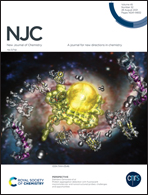Conversion of glucose to levulinic acid and upgradation to γ-valerolactone on Ru/TiO2 catalysts†
Abstract
Combining glucose dehydration and the subsequent hydrogenation in one pot is a preferable approach for process development as such a method allows in situ generation of the reactive intermediate to undergo further reaction without extra energy-intensive separation. Herein, phosphotungstic acid and various types of titania (anatase, rutile, P25) supported Ru-based catalysts were considered as the dehydration and hydrogenation catalysts, respectively. Modulating the different reactant media (N2, H2), various products were obtained with GBL–H2O as the solvent. A considerable yield (42%) of levulinic acid (LA) and γ-valerolactone (GVL) (40%) were obtained in nitrogen and subsequent hydrogen. Ru/TiO2 (rutile) was the favorable hydrogenation catalyst among the three types of Ru/TiO2. Meanwhile, a certain amount of sorbitol (36%) was obtained in pure hydrogen. The hydrogenation of glucose is more likely to occur than the glucose dehydration. The physicochemical properties of the catalysts were characterized by XRD, BET, TPR, STEM and in situ CO/FT-IR, and the results show that well-dispersed Ru particles are located on the rutile crystallites, which facilitated the hydrogenation of LA. A strong metal support interaction (SMSI) was responsible for the various microstructure properties and the different hydrogenation reactivity. This work allows a better understanding of the reaction paths of glucose conversion.



 Please wait while we load your content...
Please wait while we load your content...